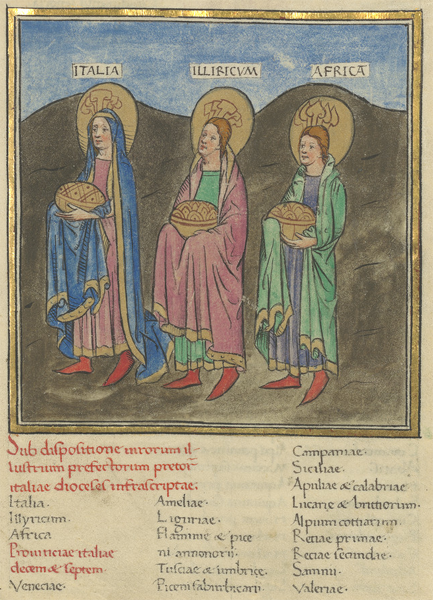
This page last modified: 14 December 2015 (various links and references added)

|
The following units are listed as being under the command of the Count of Illyricum, and said to be drawn from those listed in the Magister Peditum's infantry roster (the numbers beside the names refer to Ingo Maier's numbering scheme):
102/5.92 Sagittarii Tungri (an auxilia palatina unit) |
 Above: illustration from the Parisian manuscript (P). The Count of Illyricum does not have his own section, and thus has no accompanying frontpiece showing any towns he has under his command. The picture above is taken from the section pertaining to the Italian Praetorian Prefect, and shows personifications of the three civil Dioceses he controls: Italia, Illyricum, and and Africa. In the 4th century civil and military control of most regions was divided between separate civil and military governors; such was the case with Illyricum. |
The shield pattern for the Sagittarii Tungri (102/5.92) is missing from the manuscripts. The rest of the units' patterns are illustrated below, using the appropriate patterns taken from the Parisian manuscript, save those of the Valentinianenses (102/5.112) and Catarienses (102/5.113), which are also missing. Units whose patterns are presumed to be mislabelled have both the labelled pattern (with the label in quote marks) and the pattern I believe is most likely the correct pattern illustrated (with a question mark beside the supposed label).

Note that a Comes Illyricum does not appear in the western "index" of the Notitia (section 95/6), and there is no illustration showing any towns he controls, nor indeed any other indication that he exists other than the fact a Comes is recorded as controlling the above troops in Illyricum (cf. the Comes "Hispenias"). Jones believed that this is an indication that the office was a recent creation, ca. 420, but notes that commanders in Illyricum are noted before this date, and supposes that the office was abolished only to be revived.
This hypothesis seems rather strained. Any new Illyrican command of 420 AD would likely have featured more pseudocomitatenses units than this one does, and surely contained more units named after personages of the 5th century, rather than the 4th. The forces given above rather seem to bear the hallmarks of being the forces that finally took over Illyricum under Guneridus in 409 AD after Stilicho's death.
If this is the case, the force would presumably still have been a new creation after the initial composition of the Notitia , put together sometime in the first decade of the 5th century (exactly what Illyricum covered is something of a vexed question). Burns argues for a force that was partially assembled as early as 402 AD, and this has some attractions. Such a force would still be expected to contain some pseudocomitatenses units, if not as many as as would be required after Gaul had been overrun in 407AD.
A pair of such units are the two lanciarii units. As the Lanciarii Lauriacenses (102/5.109) and the Lanciarii Comaginenses (102/5.110) both have origins in Pannoniae primae; and yet no units called lanciarii are listed under the Dux Pannoniae primae et Norici ripensis, this suggests to me they might have transferred out of Pannonia quite some time before the Notitia was last amended, or even before it had been compiled in the first place.
The Seguntienses (102/5.100), would appear to be another transferred unit, from Britain in this case, as Seguntium is modern Caernarvon in Wales. If the Seguntienses had come from Britain, then quite possibly the next unit did too, the Tungri (102/5.100), given the Roman habit of brigading units in pairs. Indeed, both cohors I Tungrorum (154.24) and cohors II Tungrorum (154.28.1) from Britain could equally be the Tungri of the Comes Illyricum, eventually promoted to palatine status (it is a curious feature of the Notitia that no auxilia units are attested as having comitatenses status; they are all either pseudocomitatenses, or palatinae). If this force was only used in Illyricum after Stilicho's death, there would have been ample time for these units to have been promoted to palatine status, as they would have been part of the Italian (i.e. palatine) field army for the best part of a decade.
Legio Secunda Iulia Alpina (102/5.111), although not listed in any other command, is also a unit drafted in from another force - that of the defunct Comes Italiae, whose existence in the Notitia still remains in his section heading, and the space allocated in the lists for his forces, but who is not listed as controlling any troops, officers, or towns. As his territory is described as Alpine Italy, he obviously commanded the Prima Iulia Alpina (98/9.131) and the Tertia Iulia Alpina (98/9.122) as well; these two units are noted as serving in the Magister Peditum's Italian command in the Notitia.
1. Maier, Ingo; "Appendix 4: Numeration of the new edition of the compilation 'notitia dignitatum' (Cnd)"; last accessed 26 October 2015. See also for here for numbering examples. Return
2. Seeck, Otto (Ed.); "Notitia Dignitatum accedunt Notitia urbis Constantinopolitanae et Latercula prouinciarum", Weidmann, Berlin, 1876; OC.VII.44, available here (last accessed 26 October 2015). Return
3. Jones, A.H.M.; "The Later Roman Empire, 284-602; A Social, Economic, and Administrative Survey"; Blackwell, Oxford, 1964 (3 volumes); at p 354. Return
4. Burns, Thomas S.; "Barbarians within the Gates of Rome: a Study of Roman Military Policy and the Barbarians, ca. 375-425 A.D."; Indiana University Press, 1994; at p 192. Return
5. Burns, Thomas S.; "Barbarians within the Gates of Rome: a Study of Roman Military Policy and the Barbarians, ca. 375-425 A.D."; Indiana University Press, 1994; at p 177. Return
6. Maier, Ingo; "Appendix 8: Illyricum in the Compilation 'notitia dignitatum' (Cnd)"; last accessed 26 October 2015. Return

Return to the Notitia index page.